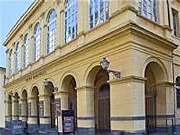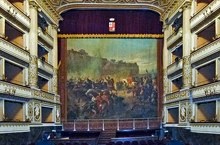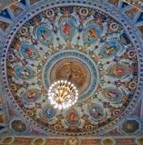


The local architect Giovanni Santini built the original theatre here in 1841 as a private commission. However, the Commune took over the project when its funding hit problems. They commissioned Virginio Vespignani to redesign and rebuild the theatre in 1853. He largely followed the floor plan of the earlier structure, but he completely redesigned the facade in what became Corso Cavour. Structural work was completed in 1862.
The theatre opened in 1866, when Marino Mancinelli conducted Donizetti’s “La Favorita”. In 1922, the theatre became known as Teatro Mancinelli in honour of Marino Mancinelli (died 1894) and his brother, the composer Luigi Mancinelli (died 1921), both of whom came from Orvieto. It was restored in 1991-3 and is much in demand, not least because of its excellent acoustics.
Interior


Virginio Vespignani suggested that the interior decoration (1863-6) should be commissioned from the Perugian Annibale Angelini and the Orvietan Cesare Fracassini. Works by the latter include:
-
✴the fire curtain, which depicts the Byzantine General Belisarius freeing the city from the Goths (the first documented event in Orvieto’s history); and
-
✴the Dance of the Hours (represented by twelve allegorical female figures) on the ceiling.

